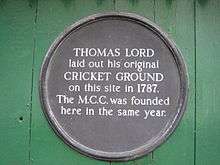Lord's Old Ground
Lord's Old Ground was a cricket venue in London that was established by Thomas Lord in 1787. It was used mainly by Marylebone Cricket Club for major matches until 1810, after which a dispute about rent caused Lord to relocate.
Matches
The first match known to have been played at Lord's Old Ground was White Conduit Club v Middlesex on Monday 21 May 1787.[1]
The first regular cricket fixture at Lord's which continues today was the annual Eton v Harrow match which was first played on the Old Ground in 1805.[1]
The inaugural Gentlemen v Players match took place at the Old Ground in July 1806.[1]
Location

Lord's Old Ground was on the site of what is now Dorset Square. Lord relocated in 1811 to Lord's Middle Ground, a site at Lisson Grove in the vicinity of Regent's Park but he lost that venue after only three years because the land was requisitioned for a canal cutting. In 1814, he opened the present Lord's Cricket Ground, formerly a duckpond in St John's Wood.
A commemorative plaque was unveiled in Dorset Square by Andrew Strauss on 9 May 2006.
References
- Arthur Haygarth, Scores & Biographies, Volume 1 (1744-1826), Lillywhite, 1862